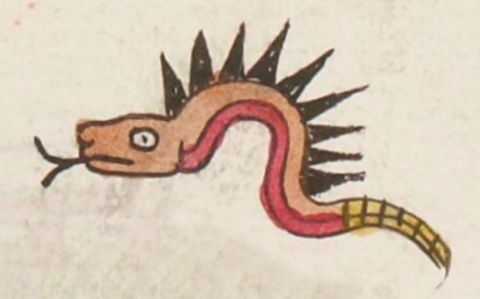Itzcoatl (TR29r)
This compound glyph for the personal name of Itzcoatl (or Itzcoatzin, in the reverential), shows the undulating body of a snake or serpent (coatl) in profile and facing toward the viewer's left, with a protruding, bifurcated tongue, an open eye, a terracota-colored body, a red underbelly, a golden or yellow rattle at the end of its tail, and black triangular shapes representing obsidian points (itztli) along its back. The name translates, literally, "Obsidian Blade Serpent."
Stephanie Wood
The contextualizing image shows Itzcoatl sitting on the petlatl and icpalli, symbols of his authority. His cape has a white diamond with a red line and white fringe on his back, and the same colored and design of trim appears along the edge of the cape where it reaches his feet. His toes are bare, but his feet appear to be on sandals. An unusally twisted hand seems to emerge from underneath the cape.
Compare this glyph for Itzcoatl with others in this collection, drawn from a variety of manuscripts.
Stephanie Wood
ca. 1550–1563
Jeff Haskett-Wood and Stephanie Wood
rulers, gobernantes, Mexica, tlatoani, tlatoque, obsidiana, piedras, navajas, cuchillos, serpientes, culebras, víboras, serpents, snakes, knives, flints, nombres de hombres, cohuatl, crótalos, ondulante

itz(tli), obsidian, https://nahuatl.wired-humanities.org/content/itztli
coa(tl), snake, serpent, https://nahuatl.wired-humanities.org/content/coatl
Serpiente de Obsidiana, o Navaja-Culebra
Stephanie Wood
Telleriano-Remensis Codex, folio 29 recto, MS Mexicain 385, Gallica digital collection, https://gallica.bnf.fr/ark:/12148/btv1b8458267s/f83.item.zoom
The non-commercial reuse of images from the Bibliothèque nationale de France is free as long as the user is in compliance with the legislation in force and provides the citation: “Source gallica.bnf.fr / Bibliothèque nationale de France” or “Source gallica.bnf.fr / BnF.”







